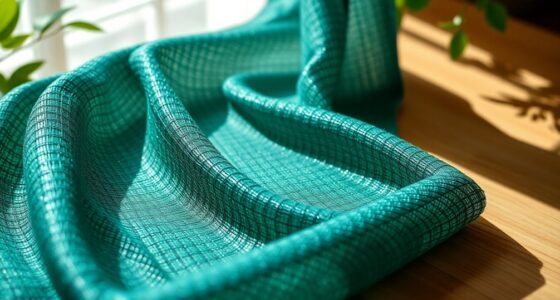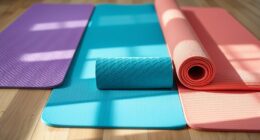Silver ions embedded in fabrics work as effective antimicrobials by neutralizing microbes on contact, making your clothing an active shield. Manufacturers use advanced processes to securely bond nanoparticles into fibers, preventing leaching and ensuring safety during regular wear and washing. These innovations enhance fabric durability and maintain antiviral properties over time. If you want to discover how this technology evolved and how it keeps you protected daily, there’s more to explore behind the science.
Key Takeaways
- Silver ions embedded in fabrics neutralize microbes, providing continuous antiviral protection during daily wear.
- Advanced manufacturing techniques ensure silver nanoparticles are securely bonded, preventing leaching and ensuring safety.
- Regular testing and certifications guarantee antiviral fabrics remain safe and effective through multiple washes.
- Innovations in textile processing optimize nanoparticle integration, enhancing durability and maintaining fabric comfort.
- Scientific research and safety standards have established silver-based antiviral fabrics as reliable, everyday protective shields.

In recent years, antiviral fabrics have gained popularity as a proactive way to reduce the spread of germs and viruses. As you explore these innovative textiles, it’s essential to understand how they work and the safety measures behind their development. One key aspect is nanoparticle safety. When silver ions are embedded into fabrics, they are often contained within nanoparticles, which are incredibly tiny particles that can effectively neutralize microbes. However, concerns about nanoparticle safety center around their potential to leach out and cause unintended health or environmental effects. Manufacturers take these concerns seriously by adopting stringent testing protocols to ensure that nanoparticles remain securely integrated into the fabric fibers, preventing any adverse exposure during regular use or washing.
Antiviral fabrics use embedded nanoparticles, carefully tested to stay secure and safe during regular wear and washing.
The textile manufacturing processes used to create antiviral fabrics are complex and carefully controlled. These processes involve multiple steps to ensure that silver ions are evenly distributed and firmly bonded to the fibers. Techniques such as coating, embedding, or chemical bonding are employed to incorporate silver nanoparticles into textiles. These methods are designed to maximize the antimicrobial properties while maintaining fabric durability and comfort. You’ll find that modern manufacturing also emphasizes sustainability, aiming to minimize waste and reduce environmental impact. This involves selecting eco-friendly chemicals and optimizing processes to lower water and energy consumption.
Understanding the textile manufacturing processes is crucial because they directly influence nanoparticle safety and the overall performance of antiviral fabrics. For example, if the bonding isn’t strong enough, silver nanoparticles might detach over time, diminishing effectiveness and raising safety concerns. Manufacturers continuously refine these processes to enhance the longevity of the antiviral properties, ensuring that your clothing or textiles remain effective through multiple washes. Additionally, the choice of manufacturing techniques impacts the fabric’s breathability, softness, and durability, which are vital for everyday use.
As you consider antiviral fabrics, it’s reassuring to know that safety is a priority in their production. Industry standards and certifications exist to verify that nanoparticle use doesn’t pose health risks. Advances in textile manufacturing processes have made it possible to produce fabrics that are both highly effective against microbes and safe for consumers and the environment. So, when you wear clothing made from these textiles, you can feel confident that cutting-edge science and rigorous safety protocols work together to keep you protected without compromising comfort or safety.
Frequently Asked Questions
How Long Do Silver Ion Fabrics Retain Their Antiviral Properties?
You might wonder how long silver ion fabrics keep their antiviral properties. Usually, their fabric durability lasts through numerous washes, but over time, silver ions can diminish. To maintain effectiveness, some fabrics allow silver ion renewal, replenishing the ions after cleaning. This process helps extend the antiviral benefits, ensuring your fabric stays protective longer. Keep in mind, proper care and renewal methods are key to preserving these properties.
Are Antiviral Fabrics Safe for Children and Sensitive Skin?
Picture a gentle guardian protecting your loved ones. Antiviral fabrics, infused with silver ions, are generally safe for children and those with sensitive skin. However, skin sensitivity and allergy risks exist, so it’s wise to check labels and test new fabrics on small skin areas first. With proper use, these fabrics can serve as a reassuring shield, offering protection without compromising comfort or safety.
Can Silver Ions Cause Environmental Harm When Washed?
You might wonder if silver ions in fabrics cause environmental harm when washed. The environmental impact depends on silver leaching during washing, which can introduce silver into water systems. While small amounts typically don’t pose significant risks, excessive silver leaching could harm aquatic life. To minimize this, choose fabrics with proven safety standards and follow proper washing instructions, reducing silver release and protecting the environment.
How Do Silver Ions Compare to Other Antimicrobial Agents?
Imagine comparing silver ions to other antimicrobial agents like copper or triclosan. You’ll find silver ions offer superior comparison effectiveness, especially against a broad range of microbes. They’re also cost-effective over time and highly durable, maintaining their antimicrobial properties through multiple washes. Unlike some agents that may degrade or cause resistance, silver ions provide a consistent, long-lasting defense, making them an ideal choice for everyday antimicrobial fabrics.
Are Antiviral Fabrics Effective Against All Types of Viruses?
You might wonder if antiviral fabrics work against all viruses. While these fabrics, crafted through advanced manufacturing processes, are effective against many common viruses, their durability can impact long-term effectiveness. Some viruses may resist certain treatments, so it’s crucial to choose fabrics tested for broad-spectrum antiviral properties. Regular washing and proper care help maintain fabric durability, ensuring your antiviral protection remains reliable against various virus types.
Conclusion
Now, you’re walking through a world where silver ions act like tiny guardians, turning your fabrics into silent protectors. These antiviral fabrics are your armor, turning everyday clothing into a shield that fights off germs effortlessly. Just as a trusty umbrella keeps you dry in a storm, these fabrics keep you safer without any fuss. Embrace this silver-powered revolution and let your clothes do the heavy lifting, turning your wardrobe into a frontline defense.









